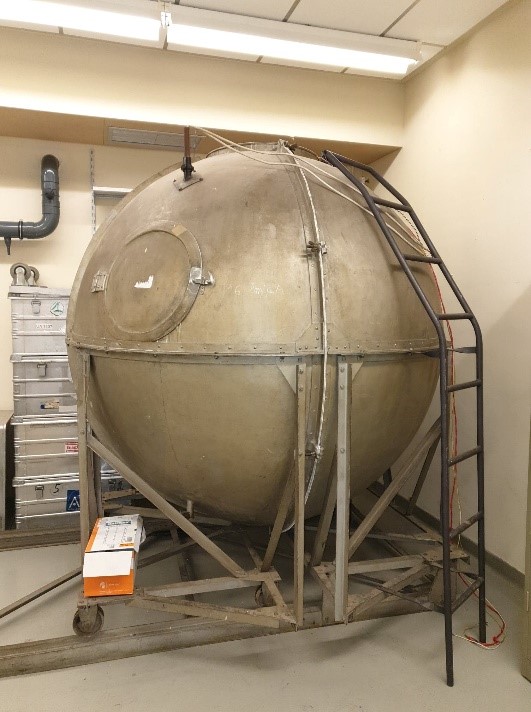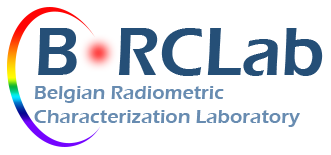The large integrating sphere
1. State of the art
An integrating sphere is a device consisting of a hollow spherical cavity. The interior is covered with a diffuse reflective coating to produce a uniform diffusing effect. The sphere is equipped with some openings (entrance and exit ports) used to either connect detectors, inject a light beam or deliver an homogeneous radiance from an exit port. An integrating sphere is dedicated to radiometric or photometric measurements. Radiometry is the measurement of electromagnetic radiation (from UV to IR), while photometry is related to the measurement of light to which human eyes are sensitive. Sphere systems can be used for two main general applications:
- as an instrument to measure the total light radiated in all directions from a lamp,
- as a light source with apparent intensity uniform over all positions within its circular aperture.
The size of the sphere depends on the application. Smaller spheres are typically used to diffuse incoming radiation (the sphere is used as a light source), while larger spheres are used to measure integrated properties like the luminous flux of a lamp or luminaries, which is then placed inside the sphere.
When used as a light source, a sphere provides a uniform radiance distribution over a specific spectrum (lambertian source). This spectrum depends on the spectral distribution of the light beam injected in the sphere and the reflectance of the coated diffuse material. Optimizations can be provided in the UV-VIS or NIR.
Note: the larger the sphere compared to the exit port, the greater the uniformity. However, the input power must increase with the sphere size to produce a same quantity of radiance at the exit. It is worth to mention that multiple sources can be mixed inside the sphere to produce a uniform output.
3. The large integrating sphere at B.RCLab
Thanks to a donation in 2019 from UCLouvain to BIRA-IASB, our laboratory is equipped with a 2 meter in diameter integrating sphere (Figure 1), entirely coated by magnesium oxide (MgO) based paint. This sphere was designed in 1932 and used by UCLouvain since de 50’s for education and photometric applications. The MgO reflectance is optimized for the visible spectral range but high value (reflectange larger than 90%) can be observed since 300 nm to at least 2500 nm. Although the paint needs to be refreshed to improve its performance, the sphere is operational. It can easily be separated into two vertically separated hemispheres, which allows convenient access for light fixture installation or maintenance work.

3. Applications
As mentioned previously, an integrating sphere allows performing both radiometric as well as photometric measurements. Table 1 summarizes the most common radiometric and photometric quantities.
|
Quantity |
Radiometry |
Photometry |
Symbol |
|
Power or flux |
Watt [W] |
Lumen [lm] |
Φ |
|
Power per unit area |
Irradiance [W m-2] |
Illuminance [Lm m-2] |
E |
|
Power per unit solid angle |
Radiant intensity [W sr-1] |
Luminous intensity [Lm sr-1] |
I |
|
Power per unit solid angle per unit projected area |
Radiance [W m-2 sr-1] |
Luminance [cd m-2] or [Lm m-2 sr-1] |
L |
|
Power per unit projected solid angle per unit area |
For radiometric applications, thanks to its large size, the sphere offers the possibility to perform flat field measurements of whole instrumentation equipped with Focal-Plane Arrays (FPA) or imagers such as CCD, CID, CMOS (for example for atmospheric research). The characterization consists in placing the whole device at the center of the integrating sphere (illuminated by a light source) and to measure the variation of the signal between pixels of the array when looking to the wall of the sphere. Indeed, each pixel will not produce the same electrical signal due to their different responsivity and a picture of a uniform field will be non-uniform.
For photometric applications, thanks to its large size, any type of light source could be placed inside the integrating sphere because its configuration allows accommodating lamp sizes from single LEDs up to large street lighting luminaires. Then the light flux can be calibrated using calibrated detectors fixed at some exit ports, or from comparison with the flux of a calibrated lamp used in the same condition.

